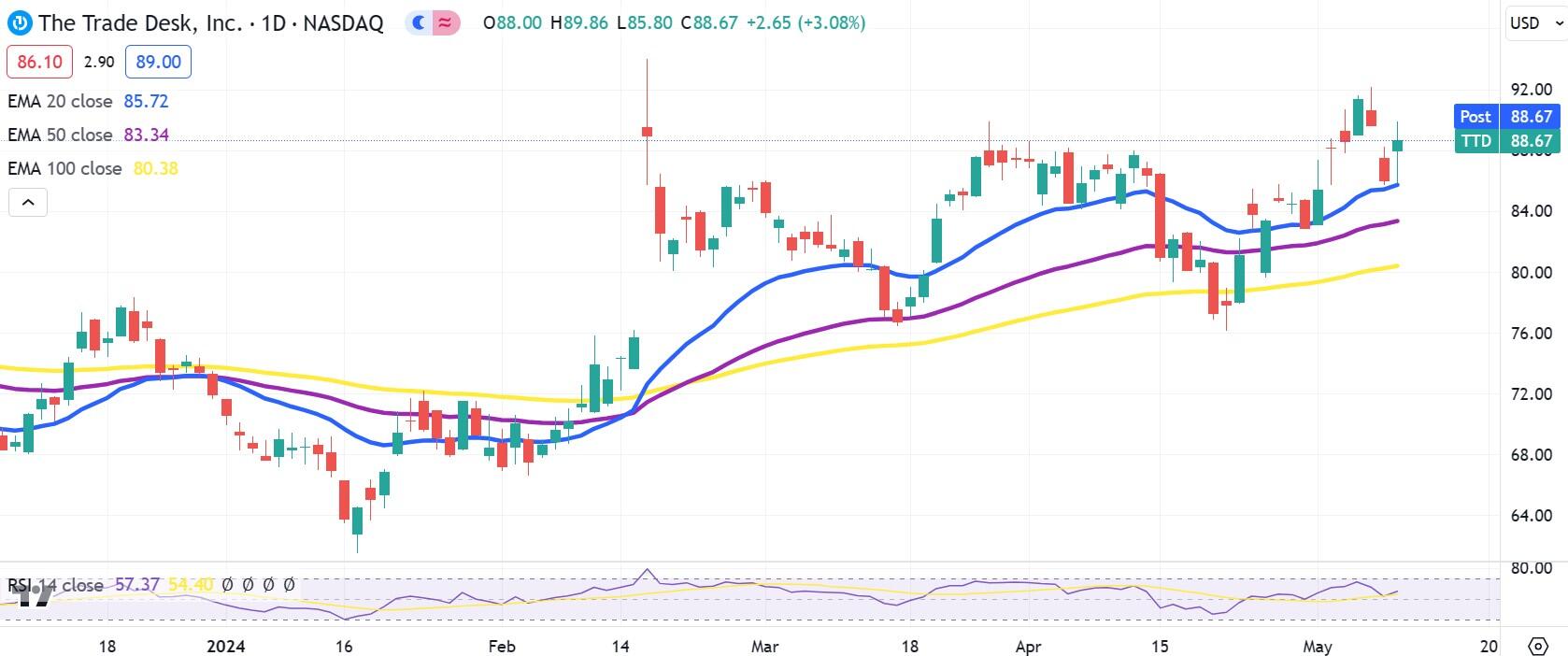- Many growth stocks have come undone this week due to earnings failures.
- The Trade Desk delivers revenue 28% higher than year earlier.
- Celsius posts revenue gain of 37% YoY, beats earnings consensus.
- The Trade Desk raises Q2 sales projection.
Celsius Holdings (CELH) and The Trade Desk (TTD) have withstood the onslaught of terrible earnings releases this week. Both stocks have jetted ahead following earnings calls showing their brands executing their strategies with gusto.
Energy drink purveyor Celsius saw its shares rise more than 9% on Thursday, ending the day up more than 6%, while two-sided digital ad marketplace TTD gained a more solemn 3%. This comes after Shopify (SHOP) and Roblox (RBLX) plunged 20% on their respective earnings announcements this week, as well as other stocks facing disgruntled traders post-earnings like Rivian (RIVN), AirBNB (ABNB), Uber Technologies (UBER), Palantir (PLTR) and Disney (DIS).
The Dow Jones Industrial Average gained 0.85%, while the S&P 500 advanced 0.51%, and the NASDAQ closed 0.27% higher.
Celsius Holdings stock news
Celsius beat its Q1 GAAP earnings per share (EPS) forecast by 8 cents when it arrived at $0.27, which was more than double per-share earnings a year prior.
Revenue was the deal-breaker as it arrived more than $34 million below consensus. However, sales of $355.7 million still rose 37% from a year earlier, and the initial pullback transitioned into gains for the stock on Thursday.
The primary issue is that Celsius’ most significant distributor, Pepsi (PEP), is reducing its inventory of the company’s energy drinks. The change seems to be in line with Pepsi’s strategy of reducing its days of inventory for many of the third-party products that it distributes.
TD Cowen analyst Robert Moskow says the inventory change will temper sales this year, but strong demand should lessen the burden.
Celsius currently has an 11.5% market share of the energy drink space in the US, and even pessimistic analysts from Morgan Stanley see this reaching 15% or more.
The Trade Desk stock news
The Trade Desk added to its long, nearly spotless record of earnings beats late Wednesday. The platform’s $0.26 in adjusted EPS beat Wall Street expectations by 4 cents. Revenue of more than $491 million bested consensus by nearly $11 million and presented a 28% increase from a year prior.
Piper Sandler analyst Matt Farrell wrote that, “Not only does [connected TV] remain the fastest growing channel for Trade Desk, but the company continues to announce partnership agreements that demonstrate the strength of the platform.”
Those new partnerships or expanded partnerships include Comcast (CMCSA), Roku (ROKU) and Disney.
Management also raised guidance for Q2 from consensus of $567 million in revenue to $575 million.
S&P 500 FAQs
The S&P 500 is a widely followed stock price index which measures the performance of 500 publicly owned companies, and is seen as a broad measure of the US stock market. Each company’s influence on the computation of the index is weighted based on market capitalization. This is calculated by multiplying the number of publicly traded shares of the company by the share price. The S&P 500 index has achieved impressive returns – $1.00 invested in 1970 would have yielded a return of almost $192.00 in 2022. The average annual return since its inception in 1957 has been 11.9%.
Companies are selected by committee, unlike some other indexes where they are included based on set rules. Still, they must meet certain eligibility criteria, the most important of which is market capitalization, which must be greater than or equal to $12.7 billion. Other criteria include liquidity, domicile, public float, sector, financial viability, length of time publicly traded, and representation of the industries in the economy of the United States. The nine largest companies in the index account for 27.8% of the market capitalization of the index.
There are a number of ways to trade the S&P 500. Most retail brokers and spread betting platforms allow traders to use Contracts for Difference (CFD) to place bets on the direction of the price. In addition, that can buy into Index, Mutual and Exchange Traded Funds (ETF) that track the price of the S&P 500. The most liquid of the ETFs is State Street Corporation’s SPY. The Chicago Mercantile Exchange (CME) offers futures contracts in the index and the Chicago Board of Options (CMOE) offers options as well as ETFs, inverse ETFs and leveraged ETFs.
Many different factors drive the S&P 500 but mainly it is the aggregate performance of the component companies revealed in their quarterly and annual company earnings reports. US and global macroeconomic data also contributes as it impacts on investor sentiment, which if positive drives gains. The level of interest rates, set by the Federal Reserve (Fed), also influences the S&P 500 as it affects the cost of credit, on which many corporations are heavily reliant. Therefore, inflation can be a major driver as well as other metrics which impact the Fed decisions.
Celsius / The Trade Desk stock charts
CELH daily stock chart
TTD daily stock chart















